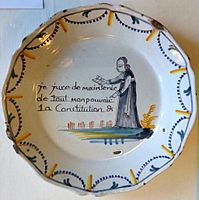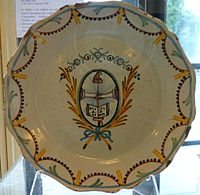Nevers faience


The city of Nevers, Nièvre, now in the Bourgogne-Franche-Comté region in central France, was a centre for manufacturing faience, or tin-glazed earthenware pottery, between around 1580 and the early 19th century. Production of Nevers faience then gradually died down to a single factory, before a revival in the 1880s. In 2017, there were still two potteries making it in the city, after a third had closed.[2] However the quality and prestige of the wares has gradually declined, from a fashionable luxury product for the court, to a traditional regional speciality using styles derived from the past.

Nevers was one of the centres where the istoriato style of
By the time of the French Revolution, Nevers wares had ceased to be fashionable and expensive,[5] but the relatively crudely painted faiences patriotiques wares commenting on political events have great interest and charm.[6] A late 19th-century revival concentrated on high-quality revivalist wares recreating past glories.
History
The tradition owes its origin to
Nevers already had a local unglazed pottery industry, and was a very suitable location for making faience. The city was near deposits of excellent pottery clay, an exceptionally good type of sand for making ceramic glaze, forests for wood for the kilns, and was on the major Loire river. The earliest dated piece by the Italians is from 1587.[9]
In 1603, the brothers received a monopoly from

The Conrade monopoly was not effective for long, with a second factory starting in 1632, and by 1652 there were four different potteries in Nevers, including one founded by Pierre Custode, whose family became the other main Nevers dynasty of potters.[12]
The French faience industry received a huge boost when, late in his reign in 1709, Louis XIV pressured the wealthy to donate their silver plate, previously what they normally used to dine, to his treasury to help pay for his wars. There was an "overnight frenzy" as the elite rushed to get faience replacements of the best quality. Nevers garden vases in blue and white were prominently used in the gardens of the
The success of the wares led to several other factories opening in the early 18th century and in 1743, the government limited the number to eleven to prevent flooding the market. In 1760, a twelfth was permitted. By this period Nevers wares had been largely replaced at the top end of the market by other makers, but were producing large quantities of less expensive wares for a broader market. They did not attempt to compete with the elegant
By this time, European porcelain was becoming cheaper and more reliable, and making life difficult for producers of high-quality earthenware across Europe.[15] The Nevers response was to produce topical faiences patriotiques with which the English were unlikely to compete (although they had done excellent business supplying the new American republic with patriotic wares).[16]

In 1838, 700 workers were reported to be employed,[17] but by 1846, only six factories remained, and by 1850, only five factories remained.[18] A porcelain manufactury in Nevers was also mentioned in 1844 by Alexandre Brongniart, but little is known about it.[19]
The manufacture du Bout du monde ("End of the World" factory) was founded in 1648, and followed the general pattern of the Nevers factories. By 1875, its fortunes had reached a low ebb and it was bought by Antoine Montagnon who had ambitious plans to relaunch it to supply the market for revivalist wares imitating 17th-century pieces, often large and complex pieces.[18][20] By 1881, it was the only factory left in Nevers. The Montagnon factory (faïencerie) was successful for over a century, with 50 employees around 1900, and its wares exhibited at international exhibitions,[18] but the factory, by then the oldest in France, finally closed in 2015.[21] In 2020, two factories remained in production, both mainly making traditional styles.[22]
Styles
The list of stylistic periods devised by the French authority du Broc de Segange in his 1863 book on Nevers faience is still often repeated,[23] though perhaps needing some adjustment. It shows several styles in use at particular dates, which is certainly the case:
- 1600–1660: Italian style
- 1650–1750: Chinese and Japanese style
- 1630–1700: Persian style
- 1640–1789: Franco-Nivernais style
- 1700–1789: Rouen manufactorystyle
- 1730–1789: Tradition de Moustiers, imitating the faience of Moustiers-Sainte-Marie in the Alpes-de-Haute-Provence
- 1770–1789: Gout de Saxe (i.e., Meissen style)
- 1789 on : Decadence.[23]
Françoise Estienne, in the 1980s, divided Nevers production in the 17th century (extended slightly at both ends) into eleven "families" based on the decoration of a study group of 1874 pieces, mainly in French museums, looking at both subjects and styles.[24]
Italian style

The Italian immigrants continued at Nevers the istoriato (narrative) style that was already in decline in Italy, until at least 1660. This used as many colours as were available using the grand feu technique of a single firing for the clay, glaze and painting, which required a firing temperature that only a few pigments could tolerate. As was usual in Italy by 1580, designs were mostly adapted from prints,[26] and the outline set out on the pot by a ponci or stencil, pushing charcoal dust through pin-pricks in a paper drawing or tracing from a print.[27]
The early pieces did not generally use distinctive marks or inscriptions, though sometimes painting "Nevers" on the base of important pieces, perhaps with a date – the earliest of these is 1589, on a dish in the Louvre.[28] As with painted Limoges enamel of the previous century, with which Nevers decoration has some similarities, a high proportion of religious subjects illustrate Old Testament subjects. As with Italian pieces, the subjects, especially those from the Old Testament or classical mythology, tended to be named on the base, sometimes even with the bible chapter noted.[29]
There is a good deal of uncertainty in the attribution of pieces between the Nevers workshops, and between Nevers pieces and those of other centres.[30] The large dish with The Gathering of Manna illustrated below, a well-known piece, had been assumed to be Italian, and 16th century, until recently. Though there are still uncertainties, it is now thought to be moulded from an Italian dish (now in the Victoria and Albert Museum in London), then painted as a matching pair of that.[31] A curious aspect of Nevers faience is that it never succeeded in producing a good red colour, unlike Rouen and other centres, the absence of which often enables Nevers pieces to be distinguished.[32]
As well as the scenes covering a whole surface, many Nevers pieces use grotesque motifs, usually on the raised border of plates or dishes, but also sometimes in the central space. These were used in Urbino maiolica in the 1580s, and also in painted Limoges enamel. In Nevers, they might surround central decoration in all styles except the Chinese, and gradually acquire their own local character.[33]
-
Sacrifice of Noah, 1580–1610, Nevers or Lyons
-
Basin or dish with The Gathering of Manna and extensive grotesques, 1620–45, probably made as a pair to an Italian dish of the 1560s.[34]
-
The manna in the desert, attributed to Antoine Conrade or Nicolas Estienne
-
Plate with two lovers and grotesque border, dated 1644, "perhaps" Antoine Conrade.[35]
Asian styles

A technique unique to Nevers in French faience, used on some pieces from about 1650 for a few decades, was to stain all the clay from which the body was made either in bleu de Nevers or (much more rarely) a mustard yellow (Wedgwood did the same for their jasperware a century later). This was then painted in white or other colours, using various styles, but rarely with more than two colours. This style is traditionally known as "Persian" or bleu persan, as decoration in white on a rich blue ground is often seen in Persian pottery of the period. However, the bird and flower painted decoration seen in most examples of the "Persian" style in fact derives more from Turkish Iznik pottery, which was reaching Europe through Italy.[36] The white-on-blue Persian style was copied elsewhere, sometimes even in English delftware.[37]

Nevers adopted Chinese vase shapes early in the 17th century, earlier than Dutch Delftware.[38] Some Nevers pieces clearly copy Chinese export porcelain in terms of their painted decoration, both the cheaper Kraak ware and better quality blue and white wares, whereas others have decoration based on Turkish, Persian or other Islamic Middle Eastern styles. These often have the blue background, which is unusual on Chinese export porcelain, where blue figures on a white ground are the norm in blue and white wares.[39][40]
Within Estienne's study group of 1874 pieces, the "Persian" family were the most numerous, with 547, then the Chinese with 374, so 921 pieces in Asian styles in total, almost half.
Much of the painting on pieces with a white ground copies that of Chinese blue and white
Unlike other French potteries, especially the porcelain factories of the early 18th century, influence from Japanese export porcelain styles such as Kakiemon is not found in Nevers wares.[44] Estienne sees the decoration à la bougie, with white imitating splashes of candle-wax on a blue ground (see below), as of Chinese inspiration. They compare with some much earlier Song dynasty wares, in particular the "oil-spot" glazes of Jian ware (around the 12th or 13th century), though Estienne is unable to explain how awareness of these could have reached France in the 17th century.[45]
-
Conrade plate, 1630s, imitating Chinese Kraak ware.
-
Garden vase, 1660–80; Chinese-style garden scene in white on a blue ground; the shape is entirely European.
-
Chinese style, 1680–1700, blue on a white ground.
-
Chinese-style vases, c. 1700
Louis XIV Court style
After about 1650, Nevers adapted the new French Court style, today called the
-
Central dish is 58 cm across, the main scene the Rape of Europa, after an illustration of Ovid by François Chauveau, published in 1674
-
Wine-cooler with The Drunkenness of Bacchus, c. 1680
-
Pair of wine jugs, c. 1685, 56 cm high. François Chauveau's Rape of Europa is again used (left).
-
Large ewer with dancing bacchantes and satyrs, 1685
-
Three Montagnon pieces in the style, after 1900
European styles

Wares were also produced in a wide variety of styles drawing on European sources, and these came to dominate production in the 18th century, as the quality of Nevers wares declined. By around 1730, a "decline of inventiveness at Nevers" becomes apparent, and later Nevers wares mostly copy
Painted scenes, rather than floral or ornamental decoration, are usually in a single colour, most often blue and white, but also the "Persian" white on blue, or other colours. In the 17th century a favourite source for scenes with figures was the immensely long pastoral novel or romance L'Astrée by Honoré d'Urfé, published between 1607 and 1627, and possibly the single most influential work of 17th century French literature. The main characters, Astrée and Celadon, spend time disguised as a shepherd and shepherdess, and this is the most popular depiction; very wide hats tend to indicate the pastoral life. These scenes do not seem to take their compositions from prints, even approximately, nor relate to any specific moment in the story. They seem to begin around 1640.[51]
Other scenes show hunting and fishing, often drawing on Flemish prints,
-
Rare Nevers "Rustic ware" dish, in the style of Bernard Palissy, 1599, by Agostino Conrade
-
Rare statue of Saint Sebastian, about half life-size, c. 1630
-
Figure sconce (candleholder)
-
Vase, 1650-1700
-
Characters from L'Astrée in the "Persian" white on blue, c. 1675
-
Armorial dish, with characters from L'Astrée, 1650–75
-
"Candle" style (decoration à la bougie), imitating splashes of candle wax,[54] late 17th century
-
Astrological plate, 44 cm, perhaps with birthchart for "Moderata Durant", late 17th century.[55]
-
decorative pilgrim flask, 1700-1725
-
Bottle, c. 1809
Faiences parlantes
The faiences patriotiques of the Revolutionary period typically have one or two figures in the central section, rather crudely painted in a few colours, with a pro-revolutionary slogan or comment below in black cursive script. The earliest examples included pro-monarchist pieces.[56] The same style had been in use before the Revolution, and continued after it, the wider grouping being called faience populaire or faiences parlantes ("talking faience"). These were more comic or satirical than political.[57] Another type of pieces in this popular style, called faience patronymique, showed the patron saint of the recipient, and were common as christening or birthday gifts. These types were made in other centres, but Nevers was the leading producer.[58]
-
Storming the Bastille, c 1789
-
A priest swears "with all my power" to maintain the Constitution; the clergy were made to so swear ("je jure de maintenir de tout mon pouvoir la constitution") in November 1790
-
"Rights of Man", c 1790
-
The Loire, with boats and the Nevers bridge, 1800
-
Tree of Love, a complex comic subject, 1803; the men are trying to hide from the women, a popular 18th century subject
Collections
Estienne's group of 17th-century pieces included 227 in the Nevers museum, 179 at Sèvres, and 116 in the Château de Saumur. The Louvre had 49 pieces, but of the highest quality.[59] J. P. Morgan collected Nevers wares, and had bought the collection of Gaston Le Breton (1845–1920), a leading art historian of the subject. Morgan left most of his "vast collections" to the Metropolitan Museum of Art in New York (accessioned in 1917), including a number illustrated here.[60] Most other major ceramic collections have examples, for example the Victoria and Albert Museum in London has over 60.[61]
See also
Notes
- ^ McNab, 18–20; Ewer page at Metropolitan Museum
- ^ "Désormais, Nevers ne compte plus que deux faïenceries", Lara Payet, 1 April 2017, Le Journal du Centre (in French); "les faienciers actuels", faiencedenevers.fr – still the case in 2020
- ^ a b Estienne, 52–54
- ^ McNab, 12, 18, 20–21; Chaffers, 150; V&A, Nevers Jardiniere
- ^ Garnier, 274–275
- ^ Though not to Garnier, 275, who is very rude about them
- ^ Coutts, 28; Moon; McNab, 12; Britannica
- ISBN 978-1-904832-77-5.
- ^ Estienne, 46
- ^ Coutts, 27–28
- ^ Garnier, 270
- ^ Garnier, 270; Chaffers, 148
- ^ Moon; McNab, 30
- ^ Chaffers, 148–149, who lists all 12; Badillet, 4; Osborne, 133; Britannica
- ^ Osborne, 133; Moon
- ^ a b Britannica
- ^ de Saint-Fargeau, Girault, Guide pittoresque du voyageur en France: contenant la statistique ..., Volume 2, 11, 1838, google books
- ^ a b c Badillet, 4
- ^ Pottery and Porcelain: A Guide to Collectors by Frederick Litchfield p.219
- ^ Dominique Romeyer, "Vingt-cinq dirigeants se sont succédé à la tête de la faïencerie Montagnon en 367 ans", Le Journal du Centre 19 May 2015
- ^ Mont
- ^ "les faienciers actuels", faiencedenevers.fr
- ^ a b Chaffers, 150
- ^ Estienne, 45 and throughout. The locations of the group are described in note 6 on p. 47 – examples outside France appear to have been ignored completely.
- ^ Metropolitan Museum page
- ^ Coutts, 27–28; McNab, 12
- ^ McNab, 12
- ^ Coutts, 28
- ^ Wilson, 202 for an Italian example; Metropolitan Museum page for the "Joseph and his brothers" plate illustrated here.
- ^ Chaffers, 149, 151–153 has an illustrated list of marks
- ^ Wilson, 334–337
- ^ Garnier, 275; Lane, 11
- ^ Estienne, 51
- ^ Wilson, 334-337; Another Urbino dish from the mould, in blue and white
- ^ Wilson, 338; Metropolitan Museum page
- ^ McNab, 18–20, 30 no 12; Estienne, 57; Some sources, for example Lane, 12 say that only the glaze was coloured.
- ^ Poole, 34
- ^ McNab, 18; Lane 11
- ^ McNab, 18–20; Estienne, 57–59
- ^ a b The Grove encyclopedia of materials and techniques in art Gerald W. R. Ward p.38
- ^ Estienne, 57–58
- ^ Estienne, 58–59
- ^ Lane, 11
- ^ Estienne's long account makes no mention of Japan.
- ^ Estienne, 60
- ^ McNab, 20–21; Moon; Lane, 11–13; V&A, Nevers Jardiniere
- ^ "Nouvelles acquisitions 2013 – 2014", musée des Arts décoratifs et du Design de Bordeaux
- ^ Lane, 13–14, 13 quoted
- ^ McNab, 16; Lane 13–14
- ^ Badillet, Chapter 4 onwards
- ^ Estienne, 54–55
- ^ Estienne, 50, 55
- ^ Estienne, 55–56
- ^ McNab, 38 no. 12; Estienne, 60
- ^ Estienne, 56
- ^ Chaffers, 149–150 gives a number of examples; Britannica, F; Monarchist jug, c. 1789
- ^ Britannica, N, F; Lane, 13–14
- ^ Britannica, F
- ^ Estienne, 47 note 6. At least today, many pieces at Nevers are loans from the Louvre.
- ^ McNab, "Foreward"; including the mustard ewer at the start of the article
- ^ a search on "Nevers Tin-glazed earthenware" returns 80 results, but some are imitations, old attributions, photos etc.
References
- Badillet, Guy, Faïences de Nevers et Marine de Loire (in French), Chapter 3, google books
- "Britannica N", "Nevers faience", Encyclopedia Britannicaonline
- "Britannica F", "Faience parlante", Encyclopedia Britannicaonline
- Chaffers, William, Marks and Monograms on Pottery and Porcelain, 1863, google books
- Coutts, Howard, The Art of Ceramics: European Ceramic Design, 1500–1830, 2001, Yale University Press, ISBN 0300083874, 9780300083873, google books
- Estienne, Françoise, "À propos d'une étude sur un centre de production de faïence en France: Nevers", Histoire, économie & société, 1989 8-1 pp. 45–60, online (in French, abstract in English)
- Garnier, Édouard, Histoire de la céramique, poteries, faïences et porcelaines chez tous les peuples depuis les temps anciens jusqu'à nos jours, 1882 reprinted 2012, Editorial MAXTOR, ISBN 9791020800183, google books
- Lane, Arthur, French Faïence, 1948, Faber & Faber
- McNab, Jessie, Seventeenth-Century French Ceramic Art, 1987, Metropolitan Museum of Art, ISBN 0870994905, 9780870994906, google books
- "Mont": "Faiencerie Montagnon", faiencedenevers.fr
- Moon, Iris, "French Faience", in Heilbrunn Timeline of Art History, 2016, New York: The Metropolitan Museum of Art, online
- Osborne, Harold (ed), The Oxford Companion to the Decorative Arts, 1975, OUP, ISBN 0198661134
- Poole, Julia, English Pottery (Fitzwilliam Museum Handbooks), 1995, Cambridge University Press, ISBN 0521475201
- Wilson, Timothy, Maiolica: Italian Renaissance Ceramics in the Metropolitan Museum of Art, 2016, Metropolitan Museum of Art, ISBN 1588395618, 9781588395610, google books
Further reading
- Champfleury (pseudonym of Jules François Felix Fleury-Husson), Histoire des faïences patriotiques sous la révolution, 1875 (3rd edn), E. Dentu, Paris, fully online (in French)
- Reginster-Le Clanche, Françoise, Faïences de Nevers, 2003, (in French)
- Rosen, Jean, Faience de Nevers, 1585–1900, 4 volumes, (in French)
- Compain-Murez, Brigitte, "Aperçu des activités humaines dans les paysages de la faïence", 5ème Conférence Paysages et jardins, 4 June 2016 (in French, many images)

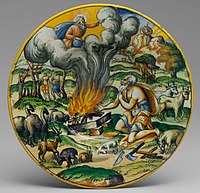
![Basin or dish with The Gathering of Manna and extensive grotesques, 1620–45, probably made as a pair to an Italian dish of the 1560s.[34]](http://upload.wikimedia.org/wikipedia/commons/thumb/0/04/Basin_or_dish_with_The_Gathering_of_Manna_MET_DP329029_%28cropped%29.jpg/200px-Basin_or_dish_with_The_Gathering_of_Manna_MET_DP329029_%28cropped%29.jpg)

![Plate with two lovers and grotesque border, dated 1644, "perhaps" Antoine Conrade.[35]](http://upload.wikimedia.org/wikipedia/commons/thumb/f/f1/Plate_with_two_lovers_MET_DP326528_%28cropped%29.jpg/200px-Plate_with_two_lovers_MET_DP326528_%28cropped%29.jpg)







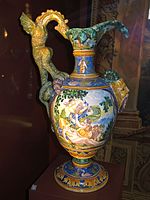



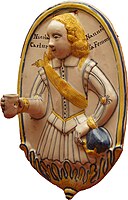

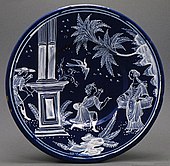

!["Candle" style (decoration à la bougie), imitating splashes of candle wax,[54] late 17th century](http://upload.wikimedia.org/wikipedia/commons/thumb/5/55/Nevers_Vase_with_decoration_%C3%A0_la_bougie.jpg/121px-Nevers_Vase_with_decoration_%C3%A0_la_bougie.jpg)
![Astrological plate, 44 cm, perhaps with birthchart for "Moderata Durant", late 17th century.[55]](http://upload.wikimedia.org/wikipedia/commons/thumb/1/11/Nevers_Factory_-_Large_Plate_-_1966.221_-_Cleveland_Museum_of_Art_%28cropped%29.tif/lossy-page1-170px-Nevers_Factory_-_Large_Plate_-_1966.221_-_Cleveland_Museum_of_Art_%28cropped%29.tif.jpg)



